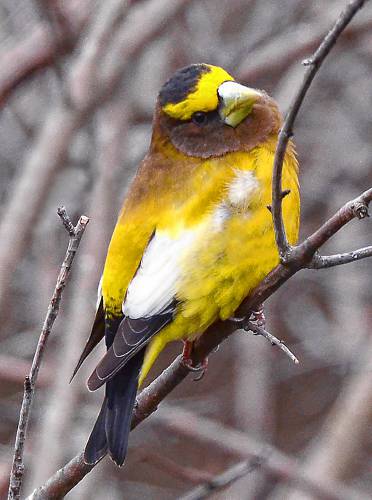[ad_1]
I am sure that some of you may have looked at today’s photo and thought, “That’s not a plant.” I know that I had made a New Year’s resolution to focus more attention on plants this year, but Nature herself threw me a curveball when this gorgeous male evening grosbeak (Coccothraustesvespertinus) appeared on my deck last week. I promise to make up for this in May with an extra plant column, but I simply could not ignore this amazing sighting.
First off, some context. When I was a boy, growing up in the 1970s, there was a brief moment in time when evening grosbeaks were all over the place. There seemed to be 20-30 of them at the winter feeders on a daily basis and this made such an impression on me that I (reasonably) thought that this was “normal.” I thought evening grosbeaks were regular winter birds that filled the back yard with dazzling color and wonderful activity.
But then, they just vanished. One winter there were grosbeaks all over the place and the next year there wasn’t a single one to be seen. It turns out that the brief period of time when they were so abundant was an extremely rare event and to my knowledge it has not been repeated since. That was 45 years ago and I have kept my eyes and ears open ever since, with little result.
Back when I had just started this column, I lived up in the town of Hawley and there were times when I was able to detect the call of an evening grosbeak as it flew over Hawley Bog. The birds were around, but they were not around in numbers larger than 1-2 birds. At my current home I have only seen evening grosbeaks on two occasions. Once, on November 7, 2007, I saw a female (or juvenile) at my hanging feeder for about five minutes. Then, last week, I saw this male for a total of eight minutes. Both occasions were the result of pure, unadulterated luck.
So what’s going on here? What is the deal with this species? Well, the answer (as in most cases when looking at ecology) is complex. Evening grosbeaks are particularly fond of spruce trees and they tend to stick to the boreal forests of the higher latitudes and altitudes. These sorts of trees will often have “good years” and “bad years” depending on the weather and during the bad years the birds may have to stray out of their normal range in search of food. This pattern of behavior is known as an “irruption” and it is common among the northern “winter” finches such as redpolls and siskins.
So, this explains why we have large flocks of common redpolls that visit every few years, but where have the grosbeaks been? Well, that brings us to some bad news for this species. According to the Cornell Laboratory of Ornithology, the population of evening grosbeaks has dropped by 74% since 1966. The reasons may include such factors as introduced diseases, habitat loss due to logging, and declines in summer food stocks (spruce budworms are a favorite) due to aerial spraying of pesticide (for the logging industry). Basically, human activity has not been kind to evening grosbeaks.
With just a little room left I want to take a look a the species’ scientific name, Coccothraustesvespertinus. The genus name “Coccothraustes” is a Greek word for the name of an unknown bird mentioned by Hesychius of Alexandria, a Greek grammarian of the 5th Century who assembled a detailed lexicon of Greek words. The name is a mashup of the Greek words “kokkos”, which means “a kernel” and the word “thrauo” which means, “to break, or shatter.” The species identifier “vespertinus” is a Latin word that means, “of the evening.” Thus, a literal translation would be something like, “the seed-breaker of the evening.” That’s a good name, in my opinion.
The word “gross” is a common English word for “large” and one look at the bird makes it easy to understand why this species was called a grosbeak. The massive beak of this species allows it to tackle all sorts of seeds and nuts, including the pits of wild cherries. If you have ever enjoyed a bowl of fresh cherries you have certainly had to deal with the pits. Imagine the prospect of chomping down on a cherry pit with enough force to crack one open. I think that teeth might start cracking before the pits do. It just goes to show that there is an ideal tool for any particular job and the grosbeak has the right tool for opening up seeds.
I’ll tell you to keep your eyes open for an evening grosbeak, but the odds of seeing one are quite small. Local birders may have information on grosbeak sightings, so an inquiry to the Athol Bird Club, or the Hampshire Bird Club might bear fruit. I’m sure that there are occasional sightings during the winter and I seem to remember a report of a few of these birds breeding in the Montague Plains, but that was a while ago. However, the sighting of this bird at my feeders is proof that every time you look out the window you might see something. So look outside, or better yet go outside and keep your eyes open. You never know what you might see.
Bill Danielson has been a professional writer and nature photographer for 25 years. He has worked for the National Park Service, the U.S. Forest Service, the Nature Conservancy and the Massachusetts State Parks and he currently teaches high school biology and physics. For more in formation visit his website at www.speakingofnature.com, or head over to Speaking of Nature on Facebook.
[ad_2]
